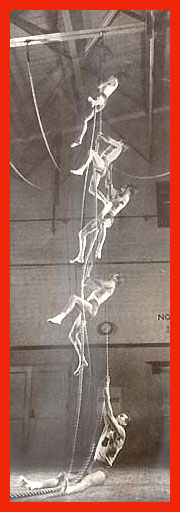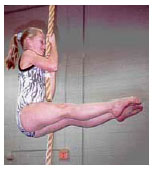 Partial History. It turns out that once upon a time - from between the 1860's to 1932 rope climbing was an olympic event. It persisted as a college competition sport into the 1960's.
Partial History. It turns out that once upon a time - from between the 1860's to 1932 rope climbing was an olympic event. It persisted as a college competition sport into the 1960's.John Gill put together a wonderful overview of both the history and the specs of the competition. Please visit these pages - the content and images are lovely, and its fabulous to read the descriptions from various periods of the respect and pleasure experienced by authors who obviously enjoyed practicing this movement. Citing from there, Gill quotes a wonderful text on gymnastics from the 50's that describes climbing this way:
Competitive rope climbing is truly an art and a skill by itself. It does not involve all the intricacies or maneuvers of apparatus work yet the art of climbing can be detailed and exacting in nature. A great deal of practice is involved to produce a champion rope climber. Since the record for climbing a rope 20' high with the hands alone is under 3 seconds it is easily understood why considerable practice is necessary for top performances. (sited as from Newt Loken & Robert Willoughby in the Complete Book of Gymnastics, 1959.)That's a pretty compelling description of a skill-based rather than just strength based practice.
Modern Practice. Apparently in 1993, it started a resurgence in the Czech republic that is still going strong, as demonstrated in this 2007 vid below:
 Kids Resurgence. Perhaps more excitingly, rope climbing is apparently also making a come back in kids gymnastics classes as part of the National Elite Physical Abilites testing (pdf), at least in the states. And the cool thing is, form here - of keeping the legs in pike position - is part of the practice - so no leg help; all upper body and core.
Kids Resurgence. Perhaps more excitingly, rope climbing is apparently also making a come back in kids gymnastics classes as part of the National Elite Physical Abilites testing (pdf), at least in the states. And the cool thing is, form here - of keeping the legs in pike position - is part of the practice - so no leg help; all upper body and core.Very cool to see girls do this so well - don't stop!
Getting Practical. Here's some awesome rope climbing teaching tips for starting with kids (how well do these translate to adults?)
Adult Tips One place where rope climbing is used more as a physical readiness test than as a competition is in the French Foreign Legion, where climbing a rope multiple times with 24kg of gear is not unknown. So here's a french foreign legion rope climbing tip.
I will now reveal the secret to the dreaded rope climb. RaiderDingo was the closest to the technique. It is very simple, and has little to do with upper-body strength. It is 90% technique. I did miss several meals (we had to climb it every day before midday meal) before I studied the guys who scooted right up the damn thing. When I saw how they did it, I almost laughed at myself. I truly believe that EVs should have to figure it out for themselves, like we anciens did. But, with all of the "upper-body strength" answers, I feel that I must give this out to the wannabes--I seldom reveal Legion secrets, as my brother anciens should know by now, so take this as Primo Info from one who knows.
Everyone makes the same mistake--they reach up as high as they can, and start to pull themselves up--this is wrong and will wear you out before you get 1 meter. The correct way is to start with both hands directly in front of your nose--elbows at 45% at all times--take short steps with your hands, keeping them directly in front of your nose at all times--NEVER, I repeat NEVER straighten your arms. Some of the testing requires that you climb it twice, without ever touching the ground between the two climbs, we had to go up once, come back down, and without setting either foot on the ground, go right back up. If you use this technique, you will have no trouble going up and down several times. I am 6 feet and 1 inch tall, slim, with ZERO upper-body strength--I could barely do 3 pull-ups, but once I got the TECHNIQUE, I never had any problem with the rope. In fact, during the testing, I started up the rope for the 3rd time without touching ground, and the Sgt. had to stop me. I think he was afraid that I was giving the secret away.
It is my OPINION, that they are not testing upper-body strength, as much as MENTAL CAPACITY. So, les gars, there you have it. If you doubt the simplicity of this, just try it at your local gym--believe me, you will be amazed. This is the only secret I will ever give away, so take it to heart and savor your victory when you astonish the cadre by scooting right up the damned dreaded rope the very first time. I do expect expensive cadeaux from all EVs who trust me and use the technique. I hope this will be the end of the "rope" questions. Tex __________________
Les hommes comme vous, je ne refuser rien.
I can confirm that this approach has been tested out by experience rope climbers who found that it made a climb "ridiculously easy"with the added tip to "stay close to the rope" and "look down a bit"
I'm keen to try rope climbing. i imagine sitting down legs out, and rather staying down. Actually, part of the challenge for me is just finding a place with a rope. Our uni gym doesn't have one (does yours?). I've run trails where there are pull up bar stations at points on the trail, but not rope climbing ones - perhaps it's a health and safety fear? Work was not happy about a rope slung down between an open area between two floors. Perhaps if it had had decorative ivy?
Climbing Simulation: Update 2011 - crosscore War Machine -
Ok since i wrote this post, i've found a way to practice rope climbing without a rope. It's called (ahem) the "war machine" made in the US by some awesome guys. Really. Awesome. If you scroll in to 55secs, the vid below shows the climbing simulation (but the whole vid is so good, you just might want to watch the whole thing.
The cool thing is that with the WM we're able to practice the techniques for climbing recommended above. Wicked. Starting with feet on a box or ball or jammed into the wall is also great. If you're interested in the WM in the US avail right from cross core; in the UK avail from Balance Performance. In either case, tell 'em dr mc sent you and they'll be happy happy.
General Queries: Do you climb a rope? if so, do you keep your legs piked out? where do you practice? would you agree it's technique?
Look forward to hearing from you.
Related Posts - in strength as practice
- asha wagner - pistoling, pull up'ing and pressing a 24kg kb
- michael castriovanni interview - tossing kettlebells with a partner
- hanging leg raise: technique first then strength?
- Pull ups 101 - how to, in many ways
- War Machine in Training - with Rannoch Donald

















